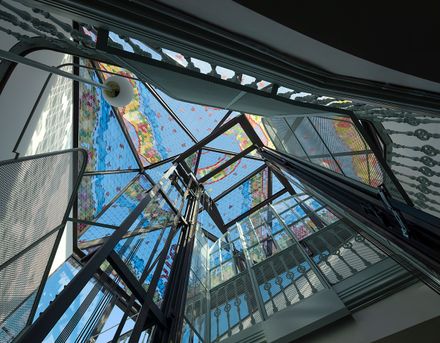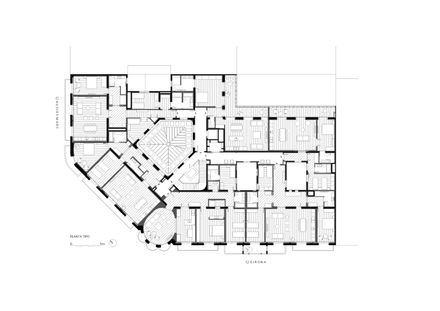Burés House
ARCHITECTS
Estudio Vilablanch, Tdb Arquitectura
CLIENT
Bonavista Developments
ENGINEER
Jg Ingenieros
STRUCTURE
Bis Structures
LEAD ARCHITECTS
Juan Trias De Bes – Tdb Arquitectura, Agnès Blanch Vallès – Estudio Vilablanch
REAL STATE DEVELOPMENT
Minim
SANITARY
Mat Barcelona
ART PIECES OF HOUSING TYPE
Marie France Veyrat
MANUFACTURERS
Antonio Lupi, Bulthaup, Carl Hansen, Cassina, Davide Groppi, De La Espada, Living Divani, Molteni & C,
Moooi, Serge Mouille, E15, Flos, Gaggenau & Bora, House Of Finn Juhl, Tato
PHOTOGRAPHS
Jordi Folch, José Hevia, Alejo Bagué
AREA
82882 ft²
YEAR
2019
LOCATION
Barcelona, Spain
CATEGORY
House
The interest of the renovation of the Burés House in Barcelona lies in the overlapping of a double condition:
Heritage Rehabilitation and Housing Rehabilitation.
Casa Burés, built between 1900 and 1905 by Francesc Berenguer y Mestres, a close collaborator of Gaudí, has a total area of 7.700m2 on six floors and is listed at Heritage Protection Level B (BCIL).
The building, which originally housed large dwellings of great architectural, heritage and ornamental value, was in an advanced state of deterioration.
The assignment consisted of recovering this icon of Catalan modernism and transforming it into a smaller residential building, adapted to contemporary requirements in terms of functionality, distribution and habitability.
If the rehabilitation of Architectural Heritage is already in itself a type of work marked by the conditions of conservation of the elements of heritage interest (Nolla pavements, polychrome ceilings, moldings, stained glass windows), when it also involves housing, the conditions of rehabilitation are more demanding due to compliance with the technical conditions required by the current normative regulations.
The fundamental aspects of the architectural intervention are as follows:
1º Maintenance of the vertical core of stairs and distribution corridors per floor.
2º Subdivision of the original dwellings from 3 units/floor to 6 units/floor, maintaining the cross ventilation through the interior courtyards.
3º Identification of the values of the architectural heritage and its compatibility with contemporary housing: Area of preservation of facades facing the street and inside the block and interior central strip for services and secondary program of housing.
The interior design project develops 3 concepts for the different areas taking into account the characteristics of each space.
- Floor Plan: The goal was to create a clear separation between the old and the new. In the area of the building facing the façade, the elements that give a singular value to the space were recovered. For the interior, the chose was to incorporate oak wood where there was no Nolla flooring and apply white as the only color.
- Main floor: The goal was to enhance the architectural and artistic heritage of the palatial spaces. The original elements were meticulously restored and accompanied by new serene and simple elements, without competing with preexisting elements.
- Ground Floor and Common Areas. The first floor of the building and the basement were transformed into three lofts and spacious common areas.
The interior design focused on recovering the original industrial character of these spaces with spacious rooms of great heights, cast iron pillars, brick walls, concrete flooring.






















